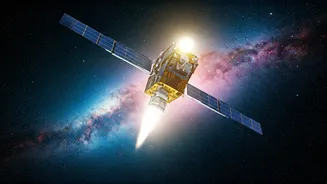The Indian Space Research Organisation (ISRO) showcased its growing capabilities once again on Sunday with the successful launch of a powerful communication satellite, CMS-03.
This satellite, weighing 4,410
kilograms, is the heaviest ever carried by an Indian rocket and is set to primarily serve the Indian Navy, enhancing its space-based communication and maritime awareness.
Although ISRO has previously launched heavier satellites, such as the GSAT-11 in 2018, which weighed over 5,800 kilograms and was sent into space using a European Ariane-5 rocket, CMS-03 demonstrates the heavy-lift power of ISRO’s LVM3 rocket.
This is the same rocket that launched the Chandrayaan-3 mission in July 2023. Only a few countries possess the capability to launch satellites weighing more than 2 tons.
Why Are Indian Satellites So Heavy?
Indian communication satellites are notably heavy because they need to provide wide coverage, high power, and long service life within a single spacecraft.
Wide Coverage And Multi-Band Capability: To serve the entire country and nearby seas, these satellites must handle numerous communication channels across different frequency bands (C band, Ku band, and sometimes Ka band).
Complex Payload Equipment: Facilitating multi-band operations requires the satellite to house various complex devices, including several large deployable antennas, high-power amplifiers, waveguides, filters, and switches to control signals. Additionally, for signal processing, they require many analogue transponders or flexible digital processors, contributing to the overall weight.
Long life And Power: To ensure longevity (typically 10-15 years), the satellite must carry extra fuel to maintain its orbit and provide necessary thrust. High-power transponders necessitate large solar panels and substantial battery banks, further increasing the satellite’s total mass.
What Rockets Does India Have?
India currently operates three main rockets for satellite launches:
Polar Satellite Launch Vehicle (PSLV): ISRO’s most reliable and frequently used rocket, the PSLV is employed to deploy small to medium satellites into low Earth orbits, particularly polar orbits. Since 1993, it has completed 63 flights, achieving a success rate of over 95.2 percent, with only three flights partially or fully unsuccessful.
Geo-synchronous Satellite Launch Vehicle (GSLV Mk II): Designed to place medium-sized satellites into geostationary transfer orbit (GTO), where satellites move in sync with the Earth, akin to communication satellites. It has flown 17 times, with three missions succeeding since last August. Four missions failed, with the latest failure occurring in August 2021 (GSLV-F10).
Launch Vehicle Mark-3 (LVM3): Previously known as GSLV Mk III, this is ISRO’s most powerful operational rocket, used to transport heavy communication satellites to GTO and large payloads to low Earth orbit (LEO). It has flown 8 times, including missions for Chandrayaan-2, Chandrayaan-3, and Gaganyaan tests, boasting a 100 percent success rate. This rocket has consistently performed well and has never disappointed.

















